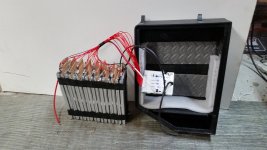Hi all, here is my battery pack for my mid drive build, I sourced the cells and bms from China. I want the safety, long life of phosphate chemistry, these cells are rated 50 amps continues discharge. Pack is 48 volt 16s 10 a/hr. Also, not having parallel packs should result in better balancing for additional cell life. I am curious why more are not using these cells .
The box is built from mostly 1/8 abs sheet chemically welded and fits snug in a Kona fire mountain frame, using existing bottle mounts. I'm gathering the parts for the build, including bbs02 750 kit, I will post piks of finished bike asap
The box is built from mostly 1/8 abs sheet chemically welded and fits snug in a Kona fire mountain frame, using existing bottle mounts. I'm gathering the parts for the build, including bbs02 750 kit, I will post piks of finished bike asap


